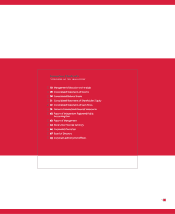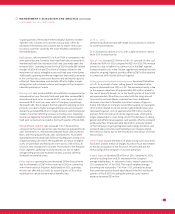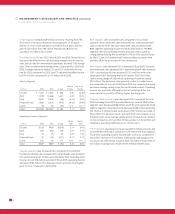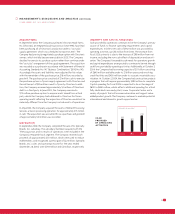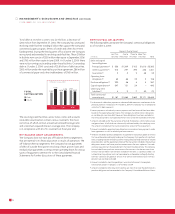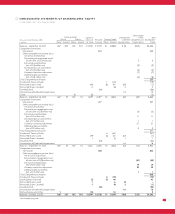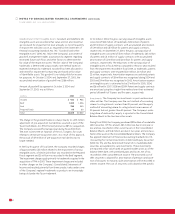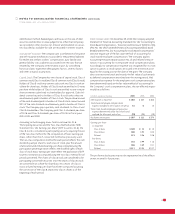Tyson Foods 2004 Annual Report Download - page 28
Download and view the complete annual report
Please find page 28 of the 2004 Tyson Foods annual report below. You can navigate through the pages in the report by either clicking on the pages listed below, or by using the keyword search tool below to find specific information within the annual report.
26
MANAGEMENT’S DISCUSSION AND ANALYSIS (CONTINUED)
The preparation of consolidated financial statements requires
management to make estimates and assumptions. These estimates
and assumptions affect the reported amounts of assets and liabili-
ties and disclosure of contingent assets and liabilities at the date of
the consolidated financial statements and the reported amounts
of revenues and expenses during the reporting period. Actual results
could differ from those estimates. The following is a summary of
certain accounting estimates considered critical by the Company.
The Company uses derivative financial
instruments to manage its exposure to various market risks, including
certain livestock, interest rates, grain and feed costs, natural gas
and other commodities used in the normal course of operations.
The Company may also hold positions for which hedge accounting,
as defined by Statement of Financial Accounting Standards No. 133,
“Accounting for Derivative Instruments and Hedging Activities”
(SFAS No. 133), as amended, is not applied. Derivative financial
instruments must be marked-to-market as of the end of each quarter
in which the positions exist. As the commodities underlying the
Company’s derivative financial instruments can experience signifi-
cant price fluctuations, any requirement to mark-to-market the
positions that have not been designated or do not qualify as hedges
under SFAS No. 133 could result in volatility in the Company’s results
of operations. See Market Risks on page 27.
The Company is subject to lawsuits,
investigations and other claims related to wage and hour/labor,
livestock procurement, securities, environmental, product, taxing
authorities and other matters, and is required to assess the likelihood
of any adverse judgments or outcomes to these matters, as well as
potential ranges of probable losses. A determination of the amount
of reserves required, if any, for these contingencies are made after
considerable analysis of each individual issue. These reserves may
change in the future due to changes in the Company’s assumptions,
the effectiveness of strategies or other factors beyond the Company’s
control. See Note 22 to the Consolidated Financial Statements.
Insurance expense for health and welfare,
workers’ compensation, auto liability and general liability risks
are estimated using historical experience and actuarial estimates.
The assumptions used to arrive at periodic expenses are reviewed
regularly by management. However, actual expenses could differ from
these estimates and could result in adjustments to be recognized.
The Company is required to assess
potential impairments to its long-lived assets, which are primarily
property, plant and equipment. If impairment indicators are present,
the Company must measure the fair value of the assets in accordance
with Statement of Financial Accounting Standards No. 144, “Accounting
for the Impairment of Disposal of Long-Lived Assets,” to determine
if adjustments are to be recorded.
In assessing the
recoverability of the Company’s goodwill and other intangible
assets, management must make assumptions regarding estimated
future cash flows and other factors to determine the fair value of
the respective assets. If these estimates and related assumptions
change in the future, the Company may be required to record
impairment charges not previously recorded. The Company assesses
its goodwill and other intangible assets for impairment at least
annually in accordance with Statement of Financial Accounting
Standards No. 142, “Goodwill and Other Intangible Assets.” See
Note 1 to the Consolidated Financial Statements.
This report and other written reports and oral statements, made
from time to time by the Company and its representatives, contain
forward-looking statements with respect to their current views and
estimates of future economic circumstances, industry conditions,
Company performance and financial results, including, without
limitation, debt-levels, return on invested capital, value-added
product growth, capital expenditures, tax rates, access to foreign
markets and dividend policy. These forward-looking statements are
subject to a number of factors and uncertainties that could cause the
Company’s actual results and experiences to differ materially from
the anticipated results and expectations expressed in such forward-
looking statements. The Company wishes to caution readers not
to place undue reliance on any forward-looking statements, which
speak only as of the date made. Tyson undertakes no obligation to
publicly update any forward-looking statements, whether as a result
of new information, future events or otherwise.



